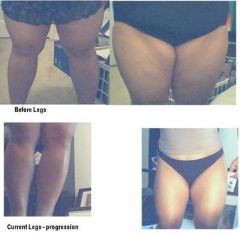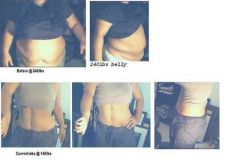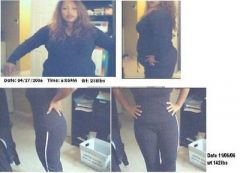-
Content Count
3,788 -
Joined
-
Last visited
Content Type
Profiles
Forums
Gallery
Blogs
Store
WLS Magazine
Podcasts
Everything posted by Telly
-
From the album: Telly's Progression Album
-
What I mean by sleep eating is waking up in the middle of the night and digging in the fridge for whatever and eating, not realizing you did it till you wake up and see a spoon with Peanut Butter residue or bread crumbs, etc. I did this alot before I was banded. I know for a fact that eating at night or while I practically slept (cuz I really had no idea I did it till the morning) contributed alot to my weight gain past few years. I almost started to slip once since I was banded but I figured out a way that will make sure this won't happen to me till I can retrain my brain and it out of my system. Sounds crazy but I have gotten a bike chain with a combination and have my husband and son lock the fridge at night. I refuse to know the combination. :huytsao I put Cereal and peanut butter, (my biggest night food) in the fridge so that it won't jump in my sleepy mouth. Funny thing is, I don't eat these items or ate them during the daytime, only at night when I wasn't aware. It's working. No weight re-gain yet and no night sleep walk eating. Anyone experiencing this weird late night occurance, sleep disturbance?
-
From the album: Telly's Progression Album
-
From the album: Telly's Progression Album
-
‘How to Lose 22lbs or 10kgs in 28 Days Without Starving or Training Like an Olympic Athlete!' By Stephen Smith BSc If you seriously want to lose 22lbs or 10 kilograms in 28 days then you must perform all of the principles exactly as recommended. Unlike the recommendations in my book, ‘Look good, feel great!', where you can pick the principles you want to use and ignore the rest and where you can even modify the principles to suit your lifestyle, these principles must be followed exactly as they are outlined. If you want extraordinary results, then you must be willing to put in an extraordinary effort! I realise that some people may be thinking, ‘But it is impossible to lose 10 kilograms of fat in a month!' I agree- it is! However, the truth is, it is impossible to only lose fat on any type of weight-loss program. You will always lose a combination of fat, Water, stored carbohydrate and some muscle. Furthermore, most people who want to lose 10 kilograms in the first place are generally retaining excess Fluid anyway, so a system that helps get rid of the excess fluid is certainly going to accelerate their results. Perform 30-60 minutes of aerobic exercise morning and night. Yes, you read that correctly, morning and night- 2 sessions a day… every day! No excuses. We're all busy, we all feel tired some mornings, but if you're serious about getting amazing results, then you must be willing to do everything necessary. When we talk about aerobic exercise, we're talking about exercise! Not walking around the shops, doing the gardening or doing housework. It must be exercise, which means your breathing rate increases, your face goes red, you sweat, you get tired- simple! Some examples of aerobic exercise include: walking (pounding the pavement at a brisk pace- not dawdling), cycling (stationary bike is ideal), swimming, rowing, stepper, cross-trainer, aerobic classes, boxing, etc. Use ‘thermogenics'. There are several very effective thermogenic supplementson the market that can accelerate your progress towards your goal. Those containing caffeine, green tea extracts and an extract from a plant called coleus forskohlii are the most effective. They will boost your metabolismand promote the release of fat from the fat stores. ‘Scorch' by MAN Sports is a good example. It contains a combination of 7 powerful herbal ingredients specifically designed to boost your metabolism, burn body fat and increase your energy. Unfortunately though, thermogenics are not ‘magic pills'. You can't expect to take a couple of thermogenic capsules and then go home and eat pizza and drink alcohol and expect to get results. Thermogenics only work when their use is combined with a good nutrition and exercise program. Take 1-2 capsules twice a day; once prior to your morning exercise session and once with your lunch. Don't take them later than 4:00pm in the afternoon because they may keep you awake at night. Before using thermogenics, see your doctor first and obtain their approval. Do not eat anything for 30 minutes after the completion of any exercise. As a result of using the thermogenics combined with the exercise, your metabolism will remain elevated for some time after the exercise session is finished. This means your body will burn fuel at a faster rate than normal. Any exercise causes the body to use carbohydrate (muscle glycogen and blood glucose) as a fuel source. This means that after the exercise is completed the carbohydrate stores in the body are low and the body will be forced to use fat as its fuel. If a meal is eaten immediately after the completion of the exercise session, the blood glucose level will rise, inducing the secretion of insulin from the pancreas. One of the effects of insulin is to stop fat burning in the body. Therefore, wait 30 minutes (but no longer because cortisol will rise) before having your next meal. Perform a weight training workout 2-4 times a week. Lifting weights is the most under-estimated way to lose fat fast! Now, before you start saying, ‘But I don't want to get big muscles!' or ‘I don't want to look like a man!', consider the following. The main purpose of lifting weights when your primary goal is to lose body fat is to preserve the muscle massyou already have. You see, muscle is the ‘engine' within which the fat, or ‘fuel' is burnt and maintaining or even increasing your muscle mass slightly will help ensure your body fat is burnt off efficiently. If you don't lift weights, your body will quite happily lose both fat and muscle as you drop the kilos. Lifting weights forces your body to maintain your muscle mass, therefore keeping your metabolism elevated and turning your body into 24-hour-a-day fat-burning machine! Incidentally, it only takes two 30 minute sessions a week to obtain the muscle preserving benefits of lifting weights. Have 5-6 small meals a day. One of the most common strategies people use to lose weight is to skip meals. Whilst reducing food intake is certainly an effective way to lose weight, having fewer meals is not the way to go. Many overweight people say, ‘I don't know why I'm overweight, I only eat once or twice a day!' Unfortunately, this is exactly why they are overweight. Having a mild calorie restriction is effective because if you consume less calories than you burn each day you will lose weight- simple! However, skipping meals forces the body to invoke its ‘Starvation Mechanism' because it thinks it is entering a famine. As a result, the body slows the metabolism to preserve energy. It also increases cortisol output and cortisol is the most powerful catabolic hormone in the body, which means it goes around the body breaking down lean tissue, particularly muscle. A loss of muscle slows the metabolism even further. Skipping meals also results in an increase in appetite, which forces you to eat larger amounts of food when you do eat. In addition to all these factors, the body also increases the activity of fat-storing enzymes, lipoprotein lipase (LPL) and fatty acid synthase (FAS), so when you do eat the food gets stored as fat. All of this results from simply skipping meals! By having a small meal every 2-3 hours throughout the day, your metabolism stays elevated and your body will happily burn fat all day long. Unfortunately though, most people are conditioned to having large meals and they automatically assume they will put on weight if they have 5 or 6 meals a day. The fact is, the ideal portion sizes for most people are actually quite small and in order to lose weight fast it is essential that you never feel full from a meal but you do feel satisfied. Also, most people find it difficult to have a meal every 2-3 hours throughout the day because they are so busy with work and/ or family commitments. Here are some suggestions to ensure you get your 5 or 6 meals a day. • Plan and prepare your meals the night before • Use Meal Replacements (Protein shakes or bars) • Select foods that are quick and easy to prepare and consume Ensure each meal contains protein. Protein is a component of all cells and makes up over half the dry weight of the human body. Furthermore, the human body is a dynamic structure, which means it is constantly building up and breaking down tissue. Just imagine a bath full of water. At one end of the bath the plug is pulled out and at the other end the tap is turned on full. The water level in the bath doesn't change but there are ‘new' water molecules entering the bath and ‘old' water molecules leaving the bath all the time. The human body is exactly the same. If the body breaks down more tissue than it builds up, then it is said to be in a catabolic state. This results in the metabolism slowing down due to the loss of muscle tissue. Having a portion of high-quality protein every few hours throughout the day provides the body with a constant supply of amino acids- the building blocks of the body. This prevents the catabolic state, promotes an anabolic state (tissue building) and therefore keeps the metabolism ‘fired-up'. If only carbohydrate or fat is consumed for a meal, for example a piece of fruit (carbohydrate) for the mid-morning meal, then the body will still enter a catabolic state because it doesn't have the building blocks (amino acids) to re-build body tissues. Protein, as its name suggests, is of primary importance. Reduce your intake of high-density carbohydrates. Most high-density carbohydrates like bread, Pasta, rice and cereals cause a rapid rise in blood glucose. This invokes the release of insulin from the pancreas, which in turn stores the glucose. The body stores glucose in the muscles and liver as glycogen and once these sites are full, the remaining glucose gets stored as body fat. Not only this, but insulin also stops the body from mobilising and utilising fat for fuel (burning fat). So if you want to maximise fat loss, you need to keep insulin to a minimum and the best way to do this is by reducing your intake of starchy carbohydrates without cutting them out altogether. Cutting them out totally is a philosophy of many low-carb diets on the market. However, these are very hard to sustain long-term and may lead to nutrient deficiencies. Each day, have a small amount (1-2 serves) of high density carbohydrates (bread, pasta, rice, cereals); a moderate amount (2-3 serves) of medium density carbohydrates (starchy vegetables and fruits); and a large amount (5-6 serves) of low density carbohydrates (fibrous vegetables). [For a complete list of carbohydrates, see pages 136-138 of the book, ‘ Look good, feel great! ] Do not have a Treat Day. Since you are expecting an extraordinary result, it is essential that you put in an extraordinary effort. Accordingly, for the next 28 days you must follow the plan exactly as it is outlined without deviating. This means you can't allow yourself to indulge in any ‘forbidden foods'. This also means avoiding alcohol for the entire 28-day period. I know this may be hard for some people but let's face it, it is only for 28 days! By committing to the plan and disciplining yourself to see it through, you are ensuring that the results will follow. Plus, the disciplines you create to help you achieve your physical goal will have a ‘carry-over benefit' to other areas of your life as well. I wish you the greatest success in achieving outstanding results! * Before using any nutritional supplement, speak with your health care professional.
-
From the album: Telly's Progression Album
-
From the album: Telly's Progression Album
-
From the album: Telly's Progression Album
-
From the album: Telly's Progression Album
-
3 days after surgery I set out on an unbreakable workout mission to tighten, lose fat and shed the old physical "me". No flour foods, no sugar. Only protein, complex cards, simple carbs. Worked out 6 days per week, 45min to 2 hours a day. Mainly started out mountain biking for 6 months... started 6 miles worked up to 41.5 miles. Each time I rode my bike outdoors, i lost 5 - 7lbs. Muscle began building, legs more defined....then joined Gold's Gym and took off from there. Hired a personal trainer and he tweaked my problem areas. Now I do plyometrics at home and cycle at the gym. It was a lifestyle change but it was worth it.
-
From the album: Telly's Progression Album
-
-
-
From the album: Telly's Progression Album
-
From the album: Telly's Progression Album
-

Me trying to be artistic with my self portraits
Telly posted a gallery image in Member Photo Gallery
From the album: Telly's Progression Album
-
From the album: Telly's Progression Album
-
-
The only lifting I have had was a Tummy Tuck with muscle repair and breast implants, no lift there. Liposuction around the waistline. Thank you ladies for commenting. I worked out incessantly for 1 straight year, 6 days per week. The muscle I built up filled in the skin space left after fat loss. I realize that now, when I don't pump iron, my arms get flabby due to less muscle density.
-
Made a new friend who happens to be a personal trainer as well as a recent former men's figure/fitness natural competition....checked out my program and also my food. I was doing some wrong things. He tweaked it a bit. Here's my new regimine. I created a personal webpage for my transformation. http://www.angelfire.com/crazy/tellytell/beginning/
-
From the album: Telly's Progression Album
-
From the album: Telly's Progression Album
-
From the album: Telly's Progression Album
-


POLL Should I have them redone to make them perfect... Breast pictures
Telly replied to princess_n_thep's topic in General Weight Loss Surgery Discussions
With my augmentation, my breasts corrected itself slightly. But from what I have gathered, a great majority of women tend to have one larger/longer breast than the other. If you are upset with them and if you are losing sleep over it then definately redo them. But no surgery has 100% guarantee. I would leave them alone. They look great.
























